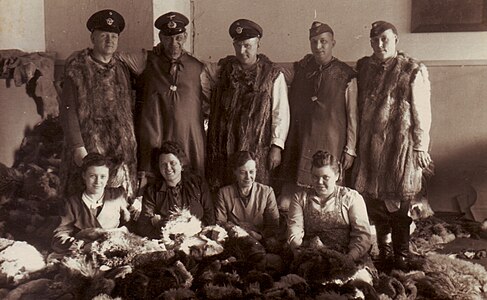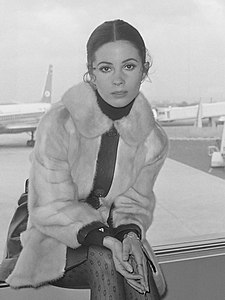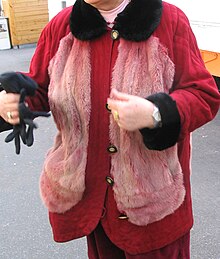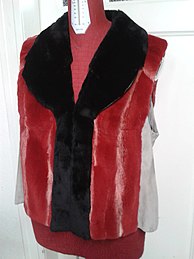Fur remodeling
A substantial part of the furrier craft , the fur transformation is also Pelzumarbeitung , order - or Neufassonierung and, more generally, even fur recycling called. In Switzerland, fur reshaping is also known as transformation , recently less so in German-speaking Switzerland.
Due to the high value, the often long shelf life and the possibility of repairing fur goods, it is very often economically sensible, in contrast to other items of clothing, to have furs that have become out of fashion or that no longer fit properly. A re-coloring of the fur in a new color is also only possible with a complete redesign.
General
If a fur no longer meets the requirements of the prevailing fashion or the taste of the wearer, or if a change in figure can no longer be adapted by a simpler change, a fur can be redesigned into a new shape. If a fur is very worn and has to be completely separated during repair, remodeling is sometimes easier than just repairing, among other things it saves the furrier having to create the pattern by copying the old part. The cost-effectiveness of a redesign results from comparing the cost of a model redesign with the price of an equal part made from new heads. To the disadvantage of the redesign, it must be taken into account that a new fur has a greater durability and often a fresher appearance than the aged material. Often, however, it is personal considerations of the fur owner that lead them to have their old or inherited garment remodeled instead of buying a new one.
If there is sufficient fur material, a redesign is usually possible without any problems. One limitation is the quality of the fur leather, which, especially when it is very old, may no longer be able to withstand being re-stretched and sewn, as it threatens to tear when subjected to this stress. In case of doubt, the leather must be checked when accepting the order. The decrease in tear strength over the years varies depending on the type of hide, tanning and type of storage.
Very often, however, additional skins are required for the redesign, called " Zupasser " in the industry . With natural-colored skins, it is usually possible for the furrier to obtain skins that match the color and the character of the coat. It is different with colored pelts, apart from black. He can try to purchase a similar old fur, or have the fur dyed to match in a fur processing company. The risk that the color is not hit sufficiently well is high. Therefore, depending on the state of fashion, the old fur is often combined with another material. This can be different types of fur, the same type of fur in a different color, leather or fabric.
By converting a coat into a jacket or a jacket into a vest, the work can be done cost-effectively without adding fur. Another possibility of redesigning without additional skins is to incorporate an inner lining from the previous outer fur into an item of textile clothing. This is a common alternative, especially for parts that have become more unsightly due to severe aging. Missing fur material can be supplemented with quilted lining, for example.
An inheritance sometimes creates a large amount of fur in a household. The number alone makes redesigning all parts for clothing purposes nonsensical. Furthermore, not every type of fur is suitable for every woman or every man or corresponds to their taste, or someone does not want to wear fur at all. In particular, inherited furs are therefore often converted into fur blankets , sometimes supplemented with fur pillows. Several different types of fur can be put together to form a larger plaid.
Ocelot jacket, redesigned and dyed red
( Dieter Zoern , 1986)Redesigned mink jacket, dyed, considerably enlarged by galonizing and nappa leather inserts (1987)
Transformed into a swinger made of recycled Persian fur and additional mink thiliki
(around 1990)
history
There was already a trade in old furs in the Middle Ages. At the time, the term “fur” usually referred to fur-lined pieces of fabric, especially in the shape of a scabbard . After the outer fabric had worn out, they had to be adapted to the new fabric cover and at the same time repaired and worn-out skins replaced. In England they already had the ability to clean and re-shear old, unsightly lambskins. However, revisions in the current, complex form are unlikely to have occurred, as a rule they had more of the character of a change. Even in 1895, in a very detailed description of the furriers in the Saxon town of Frankenberg, in addition to sales and production, above all the "patchwork" was mentioned, only incidentally also the "changes".
After furs began to be increasingly worn with the hair side facing out, before the turn of the 20th century, the craft of furriers became much more demanding, especially with regard to the harmonious joining of the skins. And it was not only the repair of ugly worn areas that became more important, but also a fur remodeling that preserved the appearance of the often elaborately artfully crafted fur, the part could not then look dismembered. Especially in times of economic depression with low purchasing power, fur remodeling was the main occupation of furriers. In a fur dictionary published shortly after the end of the Second World War (1939–1945), the author, an Austrian master furrier, wrote: “Even during times of war, as no new fur material was available, one was dependent on the revision to an increased extent. It was then particularly important to produce the best and most beautiful imaginable from the available material, to restore it to its "shine". Prudence, inventiveness and skill were the main requirements ”.
In times of prosperous fur sales, however, the furriers were particularly keen to postpone repairs, changes and redesigns to the months of April to the end of August, known in the industry as "quiet", "quiet" or even "dead time". This happens through the conversation when the furs are accepted into the summer fur preservation , through customer letters or other advertising campaigns. In the season, the overtime required to cope with the overtime increased the cost of the redesign. Until the first time after the Second World War, fur was rarely completely redesigned for fashion considerations. Furs hardly went along with fashion, they were considered timeless.
The fur remodeling is subject to financial constraints. It should offer the greatest possible cost advantage compared to buying a new one, that is to say as little work as possible and little or no additional, usually expensive and, in turn, labor-intensive additional skins. In the past, this resulted in special material combination fashions with leather, textile or other types of fur, divisions and patterns, some of which even found their way into textile fashions. In any case, the high-priced fur favors fashions in which the fur is combined with cheaper materials, i.e. as little fur as possible is used.
This requirement was met by a widely sold coat and jacket model that appeared before 1970, mostly made of mink, which looked like a complete fur coat. With extreme savings, however, the waist and the overlying belt, the side parts, an approximately seven to eight centimeter wide panel on the front edges, the cuffs, the lower sleeves and the lower collar were made of leather - also ideal for a fur-saving redesign. The problems for the furriers began, however, when, with changing fashions, customers wanted complete fur coats to be made from this little fur. A coat wasn't even enough for a jacket, for a coat in a new, possibly no longer tailored model, more than double the previous amount of fur should have been estimated. This savings model made a not insignificant contribution to depriving the mink coat of its desirability as an exclusive symbol of the regained prosperity by making it affordable for German citizens with low incomes.
The success of this model inspired the fur designers to come up with further possible combinations. Jackets were the most successful. In any case, less fur was needed for them, and with the constant increase in motorization, they were more practical to wear in the car. In the most conspicuous parts such as the collar, back and front parts, there was often still fur, but sometimes the back was also made of second material, sometimes a piece of the front parts. Leather was preferably worked in between, often structured by printing or embossing with diverse patterns. Many of the models could also be realized with fabric, but mostly leather, which looks more valuable than fur and is easier to combine with fur, was preferred. Snakeskin was also used in more expensive parts. For coats, the Hamburg fur designer Dieter Zoern designed an over plaid made of leather sewn between them, which he also presented to his colleagues. It was picked up occasionally, it was labor-intensive, but when it was redesigned it resulted in so much additional space that the old furs could be used to make the wide swinger models that were current at the time .

Around the 1970s, a rapid change in fashion began, in particular caused by the trendsetter Dior , which particularly unsettled women who wear fur. If fashion was short one year, maxi was worn the next year. Most ladies found it impossible to let the long skirt peek out from under the mink coat. Since an exuberantly crafted mink coat can only be invisibly lengthened with an expensive complete redesign, a special fur fashion was created in which one or more strips of fur were attached across the bottom, made of the same fur or as trimmings of a longer-haired type of fur, usually fox, a look that until today is taken up again and again by the fur designers. At some point, many women were fed up with the look, in which one could clearly see the subsequent extension, and they had their coats redesigned. Another possibility to extend the coat without taking the coat apart is to sew in leather strips above the hem that are so narrow that they are covered by the hair ( galonizing ). This is not invisible, but it only creates a very subtle pattern.
In the USA there were already companies in the 1930s that kept large quantities of old furs in stock and then cut them into individual parts and sold them to furriers in the space they needed for redesigning purposes. These parts have the advantage that the color change has also occurred due to the action of light and may therefore fit better than new heads, and they may also be cheaper to procure. The used fur dealer can also keep stocks of colors that are otherwise no longer available. Since the end of the 20th century, some German tobacco retailers have also been involved in this line of business, although many furriers limit themselves to only using higher quality new skins. Towards the end of the peak period of fur sales - the Federal Republic of Germany became the main sales area for fur goods after the Second World War - there were commission agents in the fur trading center Niddastraße , Frankfurt am Main, who were mainly concerned with getting passports . They had an overview of the market of the numerous resident wholesalers and looked for the best possible skins for the furs sent in by German furrier customers.
In the GDR there was a considerable number of small furrier businesses, probably with a higher per capita density than in the Federal Republic. This seems all the more astonishing because there was also a constant shortage of fur there, even rabbit fur was only given in very small quantities. However, most of the relatives from the Federal Republic of Germany sent their discarded furs to their relatives in the GDR, who then had to be redesigned and made a significant contribution to the occupancy of the family businesses. But also the larger fur-processing cooperatives, which mainly produced for West German corporations, offered fur processing along with other services. “The craft production cooperatives” of the furrier trade would be “quite capable, as was decided at the 8th Party Congress of the Socialist Unity Party of Germany, among other things, as one of the main tasks of improving the supply of the population with repair and services”. “Based on the experience gained in this area”, “it can be said that it is by no means easy to take into account the constantly evolving needs of the population. This particularly applies to fur clothing ”. For the cooperatives it was said in 1976 that the aim was to receive the furs to be reworked by April at the latest so that they could be finished in time for the cold season.
In the 2010s, Karl Lagerfeld in particular made fur in the small-size mix of materials en vogue. In addition, a fashion emerged in which different fur materials were combined over a large area in the new style, for example the upper part of the torso made of short-haired and the lower part of long-haired fur. Especially with the second variant, it makes sense to combine two old furs into one part when redesigning.
After the new production of furs has increasingly shifted to low-wage countries since the end of the 20th century, especially to Asia, service work such as fur redesign is once again the main occupation for most detail skinners. A few companies have also specialized in selling altered old furs as vintage fashion in recent years. For cost reasons, the parts are rarely completely redesigned here, but the old furs are given an individual, contemporary look through the smallest possible changes. The classic furrier business usually shies away from trading in altered old furs, as it is difficult for the customer to tell whether he is buying a new fur or an old fur that is risky.
Handbag made from a knapsack (called "Fellaffe") (post-war period)
Material mix of velvet weasel , pieces of sable and crash fabric (2015)
Work technique
Acquisition of a silver-shadow mink evening jacket
1978:
redesigned with two foxes
1987:
colored burgundy and redesigned with goat suede
1995:
worn fox cuffs and fox collars replaced by black-dyed beavers
2011:
photo, 38 years after the jacket was purchased
Mink fur shorn into "velvet mink" and redesigned together with the beaver fur into a vest
2019:
Photo, 46 years after the jacket was bought
If the fur owner has decided on a redesign, the model must be determined. Depending on the company, this is done using the fur collection in stock, according to sample parts made of fabric ("nettle models"), according to photos that may have already been brought by the customer and according to the individual customer requirements, possibly supported by sketches by the fur designer. In addition to his own designs, the fur processor has the opportunity to buy fur-suitable patterns from designers.
If a fur is to be given a new color as far as possible, this is only possible as part of a redesign. Furs during processing by purposes closed out and stretched, the dyeing the dye bath to it loses again, and the fur is running one. As a rule, the old area cannot be used in full size again.
If the item of clothing is laid flat, i.e. divided into its basic parts, torso, sleeves, cuffs, upper and lower collar, etc., in most companies all intermediate materials are removed in addition to the fur silk and the fur parts are cleaned in the lauter tun with the help of wood flour ( technical language: "purified" ). The furrier then repairs the wear spots and sets up the part according to the new pattern. The new heads are inserted in the places that best fit the old material. If the new skins deviate slightly from the material, an attempt is made to “hide” them in the less visible parts, such as the lower sleeves, sides of the torso or undercollars. With some types of fur, it is also easier to refresh the color than on the finished fur, i.e. to cover up the yellowing that has occurred due to aging, while at the same time matching the color of the added fur.
If the fur is not sufficient for the dimensions of the pattern, the fur area can be reduced by dividing the pattern into fur and leather or fabric parts adapted to the respective fashion, with long-haired pelts a galonization is possible, this is an increase of the area by from Hair covered, inter-stitched leather strips (galons). Otherwise, the fur can be expanded or lengthened with additional fur as part of the redesign. To do this, the same working techniques are used as with a new production: cutting in and omitting . In particular, the lengthening of curly and moiré fur is done by cutting. The different types of fur such as the head, torso and pump are separated and joined together in a jagged or wave shape, as invisible to the eye from the hair side as possible.
A similar procedure can be used for skins (mink) that are left out in streaks. It is very time-consuming, but often more satisfactory as a result, to separate the outlet cuts that are a few millimeters apart and to let them out by a few (!) Millimeters, with as many cuts, until the desired length is achieved. When cutting the skins that have been left out, the old skin strips are cut into one another, because they fit better together, and the new skin is made into separate strips that are inserted at a suitable point.
The ready-sewn jacket or coat parts are stretched wet according to the pattern, as with the new part, and adjusted after drying. Then the hair that has been squeezed by the purpose is finished, that is, smoothed and loosened up. The interior ingredients are applied to the leather again. It is often advisable to secure the leather against tearing with a pricking fabric, even if this did not seem necessary when it was new. The edges are banded for stabilization and the individual parts are then joined together with the fur sewing machine to form the new model. Once the fur is finished, it is often tried on at the customer's facility before it is finally finished. After a possible change, the fasteners and a new silk lining are sewn in, the use of the old lining would usually be patchwork and uneconomical.
It is advisable to let the processor give you the remaining fur that always occurs so that you have suitable material available for any subsequent repairs or changes.
Tying a fur remodel
Redesign to vest, Kalgan lamb , leather side before feeding (2017)
Redesign recommendations for different types of fur, USA, 1950
In 1950, an American furrier book published a list of 14 types of fur that were popular there at the time, in which, among other things, the durability as well as the repair and redesign options were assessed for the specialist colleagues. In the meantime, however, fur refinement has made considerable progress, so that some of the concerns about the better quality of fur leather and the dyeing are no longer applicable. Some of the problems described seem to be easier to solve in Europe today.
The author David D. Kaplan has also listed the estimated costs of various services in his work. As the cheapest, he calls the redesign of shorn lamb ( beaver lamb ), the most expensive that of mink (about 2.5 to 3 times as much), each without the addition of fur. In addition to many other fur types, rabbit fur, sable and chinchilla, for example, are not included in the list.
The details of the redesigns are as follows:
- Buenolamm ("American Broadtail "), Tingona lamb, Lincoln lamb, Bombay lamb : only easy to cut out modifications and only out of season
- Badger : In collar form [apparently not used as a coat or jacket at the time]
- Beaver : Old dry-leather beavers should not be reworked too extensively. Pieces should be placed where they are least visible. The skins have to be let in or out individually.
- Foxes : A redesign of scarves into jackets is possible, if not worn, with the addition of fur
- Zickel : Remodeling is not advisable, except for works that are simply cut out, or perhaps as a cloak
- Leopard : Reshaping is extremely difficult. Depends on the difference between the new pattern and the old one.
- Mink : If the leather has not dried out and is no longer workable, the mink can be repaired or reworked. Matched skins have to fit perfectly or be moved [move, a working technique in which half ofthe skin is sewnwith the grunt , the middle of the skin, to the grots of a skin thatdoes not fitwell in color]. Dyeing or re-dyeing is possible on yellowed coats if the leather is still stable.
- Muskrat : Black-colored, sheared muskrat ("Hudson seal") can be redesigned very well. Natural bisam is not easy to work with, when it is old it can no longer be used.
- Persian , black : Basically all types of repair and redesign are possible as long as the leather does not split or break
- Persian, gray : If the fur has been left out, repair and makeover is extremely difficult. Trimming and adjusting new fur is even more difficult. Can be colored gray.
- Kanin : Can in principle be repaired and redesigned, provided that the leather is still strong enough. Extensive redesigns are not the order of the day. A simple prong is best as a fur connection.
- Raccoon : The remodeling is usually problematic with omitted parts
- Skunk : Repairing and reshaping is difficult when additional fur is needed. In particular with old furs it is very difficult to sort suitable furs.
- Feh : Not particularly difficult.
See also
Web links
Individual evidence
- ↑ a b c David G. Kaplan: The Fur Book . Copyright The Reuben H. Donnelley Corporation, New York 1950, pp. 187-193, 233-254 (English).
- ↑ a b c David G. Kaplan: World of Furs . Fairchield Publications. Inc., New York 1974, pp. 99-102 (English).
- ^ Elspeth M. Veale: The English Fur Trade in the Later Middle Ages . Clarendon Press, Oxford 1966, p. 13 (English).
- ^ Albin König: The furrier in Frankenberg in Saxony . In: Writings of the Association for Social Policy LXIII. Investigations into the situation in Germany. 2nd volume . Duncker & Humblot, 1895, pp. 312-341.
- ↑ a b Alexander Tuma: Pelz-Lexikon. Fur and Rauhwarenkunde, Volume XX . Alexander Tuma, Vienna 1950, p. 39–40, keyword “new composition” .
- ↑ a b H. Weck: fur clothing. The tasks of the craft businesses as providers of repairs and services . In: Brühl No. 1, January / February 1976, VEB Fachbuchverlag Leipzig, pp. 29-30.
- ↑ Arthur Samet: Pictorial Encyclopedia of Furs . Arthur Samet (Book Division), New York 1950, pp. 385-386. (English).
















